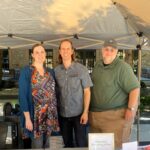While the sun began to set after a balmy afternoon of Nov. 1, members of the Mexican American Student Association set up the refreshment table for their Dia De Los Muertos celebration in the courtyard of the Central Academic Building at Texas A&M University-San Antonio.
Kayla Garcia, a senior and the club’s community service chair, stacked boxes of brown and white conchas — pan dulce shaped like shells — and started the coffee machines.
Dia De Los Muertos, or Day of the Dead, is a holiday originating from Mexico and celebrated throughout the Americas. It is an amalgam of Christian and indigenous customs that celebrate the deceased and is celebrated in the United States from Nov. 1 to Nov 2. It views death as an inevitable stage of life to be revered instead of feared, and many in the MASA club have fond memories celebrating with their families.
For club president Claudia Martinez Garcia, the celebration, specifically a dance to be performed by matachines, is an “appreciation of our culture. With the beating of the drums and when you see them do their thing, it is awesome.”
Matachines are dance troupes whose performances are often venerations to the Virgin de Guadalupe and often showcase themes of good versus evil. Claudia Martinez Garcia’s mother and aunts performed with their troupe, Grupo de Oracion from St. Mary Magdalen Catholic Church, which Garcia pronounces as “Santa Maria Magdalena.”
Adjacent to the students preparing pink lemonade and setting up a face painting station, the matachines — 18 women and girls and two men — arranged their attire of red and gold, finally putting on a vest with a sequined Virgin. In each of their hands was a gourd-shape rattle and another instrument that resembled a hunter’s bow. The men wore suits of stripes of fabric, both with masks and carrying a whip. Another faction of the group, the drummers, tied red bandanas on their head.
As they arranged themselves in front of an altar placed in front of the entrance of CAB, Garcia introduced Isaac Alvares Cardenas, spiritual leader of the Tap-Pilam Coahuiltecan Nation.
“Welcome to the land of spirit waters, also known as San Antonio,” Cardenas said to the crowd drawn in by the free pan dulce and face painting. “I am very proud to be conducting this blessing, and for these matachines. Do you know that their performance is actually a prayer? A prayer to the pathetic, pitiful beings that we are.”
After he blessed the event and its participants with white mountain sage, the matachines begin their dance, a feat of endurance lasting over 20 minutes to sweeps of bells and the beat of drums in front of the altar.
On the altar was a statue of the Virgen de Guadalupe with adornments of paper marigolds and candles and photos of iconic Chicanos like Cesar Chavez mixed with candid photographs of families. The altar included a cup of coffee and pan dulce, what Cardenas called “burnt offerings” so the ancestors can eat.
The night concluded with a performance by the Mariachi Toritos, a group that has performed together for over 30 years.
As the crowd waned, their performances became more personal, directing their rendition of “Si Nos Dejan” to the cameras of students Snapchatting the event.
Their songs inspired the members of the matachines, who had already removed most of their beaded costumes, to dance and enjoy each other’s camaraderie in a circle. One dancer invited a teenage boy and reeled him in, holding him tight as she smiled to the evening’s soundtrack.
As the songs ended and the altar was rolled back into the building, David Zamarripa of the Mariachi Toritos described his contentment to be a part of the celebration.
“The fact that [the campus] is doing this, this is conserving our culture,” Zamarripa said.






